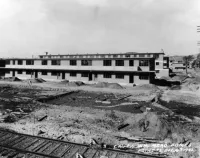Share what you know,
and discover more.
Share what you know,
and discover more.
Mar 08, 2022

-

- Charmaine Bantugan
William Mead Homes
The William Mead Homes public housing development was the eighth project built by the Housing Authority of the City of Los Angeles (HACLA). It was one of many local garden apartments built as a result of the 1937 Housing Act. This act provided for subsidies from the federal government to local public housing agencies to improve living conditions for low-income families. William Mead Homes contains a combination of two- and three-story Modern garden apartments on a fifteen-acre property. The buildings are organized into five blocks that largely adhere to the pattern of the surrounding street grid. The three-story buildings are arranged in rows parallel to Main Street, with the two-story buildings intersecting at right angles. This arrangement creates a series of sheltered, semi-private courtyard spaces throughout the complex. The buildings are set back from the streets by strips of lawn, with paved walkways leading to each unit. An elementary school occupies an entire block centrally located along the Main Street frontage of the housing complex. This garden apartment development is a remarkably intact example of a modern property type that continues to provide a thoughtfully designed living experience today, just as it did during World War II. HISTORY: Completed in 1942 after several years of delays, William Mead Homes was designed by chief architect P. A. Eisen in collaboration with Norman F. Marsh, Herbert Powell, Armand Monaco, A. R. Walker, and David D. Smith. Its landscape was designed by prolific landscape architect Ralph D. Cornell. Named after local politician William Mead, an early advocate of improved living conditions, the garden apartment complex had quotas limiting residency to low-income citizens who had lived in Los Angeles for at least a year. It also restricted African-American residency to seven percent, but the quota was removed in 1943 after protests by civil rights and union groups. In the same year, the complex quickly filled with defense industry workers who had been suffering from an acute housing shortage. The Los Angeles Times noted that the need for housing was especially great in the "industrial section of the city where so many of the smaller plants are engaged in war production." The completed project, with its arrangement of brick apartment buildings set amid green lawns, remains in notable contrast to the surrounding blocks of industrial uses. Photo by Hunter Kerhart
William Mead Homes
The William Mead Homes public housing development was the eighth project built by the Housing Authority of the City of Los Angeles (HACLA). It was one of many local garden apartments built as a result of the 1937 Housing Act. This act provided for subsidies from the federal government to local public housing agencies to improve living conditions for low-income families. William Mead Homes contains a combination of two- and three-story Modern garden apartments on a fifteen-acre property. The buildings are organized into five blocks that largely adhere to the pattern of the surrounding street grid. The three-story buildings are arranged in rows parallel to Main Street, with the two-story buildings intersecting at right angles. This arrangement creates a series of sheltered, semi-private courtyard spaces throughout the complex. The buildings are set back from the streets by strips of lawn, with paved walkways leading to each unit. An elementary school occupies an entire block centrally located along the Main Street frontage of the housing complex. This garden apartment development is a remarkably intact example of a modern property type that continues to provide a thoughtfully designed living experience today, just as it did during World War II. HISTORY: Completed in 1942 after several years of delays, William Mead Homes was designed by chief architect P. A. Eisen in collaboration with Norman F. Marsh, Herbert Powell, Armand Monaco, A. R. Walker, and David D. Smith. Its landscape was designed by prolific landscape architect Ralph D. Cornell. Named after local politician William Mead, an early advocate of improved living conditions, the garden apartment complex had quotas limiting residency to low-income citizens who had lived in Los Angeles for at least a year. It also restricted African-American residency to seven percent, but the quota was removed in 1943 after protests by civil rights and union groups. In the same year, the complex quickly filled with defense industry workers who had been suffering from an acute housing shortage. The Los Angeles Times noted that the need for housing was especially great in the "industrial section of the city where so many of the smaller plants are engaged in war production." The completed project, with its arrangement of brick apartment buildings set amid green lawns, remains in notable contrast to the surrounding blocks of industrial uses. Photo by Hunter Kerhart
Mar 08, 2022
William Mead Homes
The William Mead Homes public housing development was the eighth project built by the Housing Authority of the City of Los Angeles (HACLA). It was one of many local garden apartments built as a result of the 1937 Housing Act. This act provided for subsidies from the federal government to local public housing agencies to improve living conditions for low-income families.William Mead Homes contains a combination of two- and three-story Modern garden apartments on a fifteen-acre property. The buildings are organized into five blocks that largely adhere to the pattern of the surrounding street grid.
The three-story buildings are arranged in rows parallel to Main Street, with the two-story buildings intersecting at right angles. This arrangement creates a series of sheltered, semi-private courtyard spaces throughout the complex.
The buildings are set back from the streets by strips of lawn, with paved walkways leading to each unit. An elementary school occupies an entire block centrally located along the Main Street frontage of the housing complex.
This garden apartment development is a remarkably intact example of a modern property type that continues to provide a thoughtfully designed living experience today, just as it did during World War II.
HISTORY:
Completed in 1942 after several years of delays, William Mead Homes was designed by chief architect P. A. Eisen in collaboration with Norman F. Marsh, Herbert Powell, Armand Monaco, A. R. Walker, and David D. Smith. Its landscape was designed by prolific landscape architect Ralph D. Cornell.
Named after local politician William Mead, an early advocate of improved living conditions, the garden apartment complex had quotas limiting residency to low-income citizens who had lived in Los Angeles for at least a year. It also restricted African-American residency to seven percent, but the quota was removed in 1943 after protests by civil rights and union groups.
In the same year, the complex quickly filled with defense industry workers who had been suffering from an acute housing shortage. The Los Angeles Times noted that the need for housing was especially great in the "industrial section of the city where so many of the smaller plants are engaged in war production."
The completed project, with its arrangement of brick apartment buildings set amid green lawns, remains in notable contrast to the surrounding blocks of industrial uses.
Photo by Hunter Kerhart
Posted Date
Mar 07, 2022
Historical Record Date
Mar 08, 2022
Source Name
Los Angeles Conservancy
Source Website
Delete Story
Are you sure you want to delete this story?











